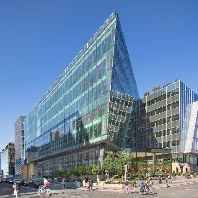Jones Lang LaSalle's Q3 European Office Clock highlights that prime office rents continued to grow during the quarter, albeit at a slower pace. The Jones Lang LaSalle Office Rental Index rose by a modest 0.7% over the quarter, driven by London, Moscow and Stockholm.
Patricia Lannoije, Head of Research BELUX at Jones Lang LaSalle, said: "The research also shows that demand for office space decreased slightly over the quarter, but stands 36% higher than a year ago with net absorption remaining positive. Further yield compression pushed capital values higher; the capital value index increased 4.7% over the quarter. Yield compression was witnessed in 13 out of 24 markets with Paris and Moscow both experiencing compression of 50 basis points."
European office occupational markets
The majority of Europe's economies continue to recover - albeit with substantial differentials. This is reflected in the Q3 2010 rental clock. This quarter, 14 of the 34 'clock markets' are now at or beyond 6 o'clock with the majority moving further through the 'bottoming out' quadrant. Prime rents across the region increased modestly, with the Q3 Office Index, based on the weighted performance of 24 markets, increasing by 0.7% over the quarter. This continued the growth seen since the beginning of the year, albeit at a slower pace. The increase was driven by Moscow (+6.3%), Stockholm (+5.4%) and London (+2.9%). Rents were unchanged for the rest of the Index markets including Brussels and Luxembourg with the exception of Spanish Cities with rents in Madrid decreasing by -2.7% and by -2.5% in Barcelona. Hefty incentives remained a feature of many markets and net effective rents were on average 17% below prime face rents, with the largest spread reported in the UK, Ireland and some Dutch markets. There also remained a clear differential between prime and secondary space with rents for secondary space remaining under downward pressure.
As economic growth returns, occupiers are increasingly committing to deals, although much activity remains driven by consolidation and churn. With 2.5 million m² transacted in Q3 2010, office take-up decreased by 8% over the quarter. This is not unusual given the summer season and, compared to this time last year, take-up was 36% higher and only 5% below the five year average. And comparing the first nine months of 2010 with the same period last year, take-up was already 39% higher. In Brussels, take-up in Q3 reached 77,000 m², 30% down compared to the second quarter but still 15% higher year-on-year. Total take-up during Q1-3 2010 reached 344,000 m² which is 80% above last year's level and back on the five year average. In Luxembourg, with a volume of 23,700 m² registered during Q3 10, the take-up has reached 72,400 m² so far in 2010. Even though it remains below the five year average, this is up 23% in comparison to same period last year.
The European Commission's economic sentiment indicator illustrated further improvement in September to reach its highest level since March 2008. However, the public deficit across Europe is likely to drive cost cutting and austerit
European office occupational markets
The majority of Europe's economies continue to recover - albeit with substantial differentials. This is reflected in the Q3 2010 rental clock. This quarter, 14 of the 34 'clock markets' are now at or beyond 6 o'clock with the majority moving further through the 'bottoming out' quadrant. Prime rents across the region increased modestly, with the Q3 Office Index, based on the weighted performance of 24 markets, increasing by 0.7% over the quarter. This continued the growth seen since the beginning of the year, albeit at a slower pace. The increase was driven by Moscow (+6.3%), Stockholm (+5.4%) and London (+2.9%). Rents were unchanged for the rest of the Index markets including Brussels and Luxembourg with the exception of Spanish Cities with rents in Madrid decreasing by -2.7% and by -2.5% in Barcelona. Hefty incentives remained a feature of many markets and net effective rents were on average 17% below prime face rents, with the largest spread reported in the UK, Ireland and some Dutch markets. There also remained a clear differential between prime and secondary space with rents for secondary space remaining under downward pressure.
As economic growth returns, occupiers are increasingly committing to deals, although much activity remains driven by consolidation and churn. With 2.5 million m² transacted in Q3 2010, office take-up decreased by 8% over the quarter. This is not unusual given the summer season and, compared to this time last year, take-up was 36% higher and only 5% below the five year average. And comparing the first nine months of 2010 with the same period last year, take-up was already 39% higher. In Brussels, take-up in Q3 reached 77,000 m², 30% down compared to the second quarter but still 15% higher year-on-year. Total take-up during Q1-3 2010 reached 344,000 m² which is 80% above last year's level and back on the five year average. In Luxembourg, with a volume of 23,700 m² registered during Q3 10, the take-up has reached 72,400 m² so far in 2010. Even though it remains below the five year average, this is up 23% in comparison to same period last year.
The European Commission's economic sentiment indicator illustrated further improvement in September to reach its highest level since March 2008. However, the public deficit across Europe is likely to drive cost cutting and austerit
















